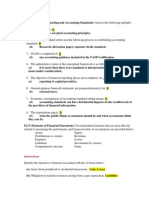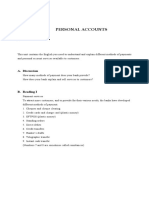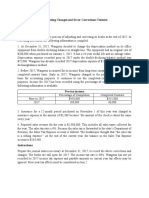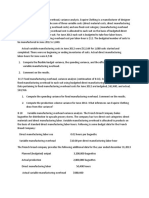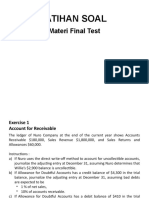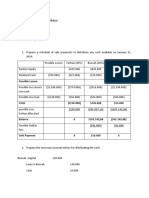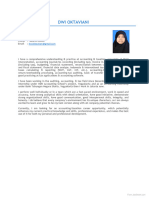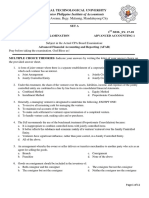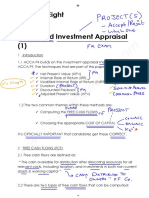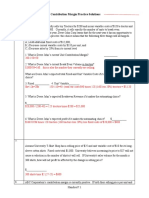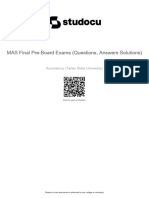Financial Accounting: Overview of Corporate Financial Reporting
Financial Accounting: Overview of Corporate Financial Reporting
Uploaded by
Abir ShahariarCopyright:
Available Formats
Financial Accounting: Overview of Corporate Financial Reporting
Financial Accounting: Overview of Corporate Financial Reporting
Uploaded by
Abir ShahariarOriginal Title
Copyright
Available Formats
Share this document
Did you find this document useful?
Is this content inappropriate?
Copyright:
Available Formats
Financial Accounting: Overview of Corporate Financial Reporting
Financial Accounting: Overview of Corporate Financial Reporting
Uploaded by
Abir ShahariarCopyright:
Available Formats
Understanding
Financial Accounting
Third Canadian Edition
By Christopher D. Burnley
Prepared by Debbie Musil, FCPA, FCMA
Chapter 1
Overview of Corporate Financial
Reporting
This slide deck contains animations. Please disable animations if they cause issues with your device.
Copyright ©2022 John Wiley & Sons, Canada, Ltd.
Learning Objectives (1 of 2)
LO1 – Define financial accounting and understand its
relationship to economic decision-making
LO2 – Identify the main users of financial accounting
information and explain how they use this
information
LO3 – Describe the major forms of business organization
and explain the key distinctions between them
Copyright ©2022 John Wiley & Sons, Canada, Ltd. 2
Learning Objectives (2 of 2)
LO4 – Explain the three categories of business activities and
identify examples of transactions related to each
category
LO5 – Identify and explain the content and reporting
objectives of the four basic financial statements and
the notes to the financial statements
Copyright ©2022 John Wiley & Sons, Canada, Ltd. 3
What Is Financial Accounting?
• Process of capturing, analyzing and reporting
transaction information to financial statement users
• Statement users include:
o Investors
o Creditors
o Management
• Annual report: reports the results of the company’s
activities during the year
Copyright ©2022 John Wiley & Sons, Canada, Ltd. 4
Business Stakeholders
Questions that stakeholders in a business may be asking
Business Stakeholders Potential Questions They May Be Trying to Answer about the Business
Employees, unions Is the business profitable? Will I earn a bonus this year? Can the company afford to
negotiate increased wages? Is the company pension plan in decent shape?
Management How do this year’s sales compare with last year’s? How do they compare with the
budget? Are we maintaining our profit margins on certain product lines? How much do
we owe our employees and suppliers?
Auditors, federal and provincial government Has the company presented its financial information fairly? How does the company’s
departments, legislators financial information compare with the information submitted for taxation or payroll
purposes?
Potential investors, customers What are the long-term prospects for this company? Has the management team done a
reasonable job? Will this company be around to honour its warranties?
Stock analysts, brokers, financial advisors, What are the company’s trends? What are the prospects for this company? How has this
business reporters company performed relative to expectations?
Stock exchange regulators Has the company complied with the financial reporting standards and listing
requirements?
Shareholders, board of directors Has the company generated a sufficient return on our investment? How effectively has
management used the resources at their disposal? Does the company generate enough
income to be able to pay dividends?
Creditors, suppliers, landlords Should we extend credit to this company? Is this a credible and successful company that
we want to attach our brand to? Should we enter into a lease with this company?
Copyright ©2022 John Wiley & Sons, Canada, Ltd. 5
Financial Statement Users
• Internal users:
o Management
• External users:
o Shareholders o Other corporations,
o Board of Directors including competitors
o Potential investors o Security analysts
o Creditors o Credit-rating agencies
o Labour unions
o Regulators
o Taxing authorities o Journalists
Copyright ©2022 John Wiley & Sons, Canada, Ltd. 6
Users - Shareholders, the Board of
Directors and Potential Investors
• Includes shareholders, the board of directors and
potential investors
• Shareholders have invested resources in the
company in exchange for a share of its ownership
• Corporations may be either:
o Private companies with a single shareholder
o Public companies with 1000’s of shareholders
requiring a board of directors
Copyright ©2022 John Wiley & Sons, Canada, Ltd. 7
Additional Financial Statement Users
• Additional Financial Statement Users also Include:
• Creditors
o Financial Institutions and other lenders
o Suppliers, employees and various levels of
government
• Regulators
• Taxing Authorities - CRA
• Other Users
Copyright ©2022 John Wiley & Sons, Canada, Ltd. 8
What Is a Corporation?
• Corporations are owned by shareholders who have
provided cash or other assets in exchange for share
certificates
o Called common shares
• Are separate legal entities, distinct from owners
• Two main types:
o Public companies
• Company’s shares are listed on a public stock exchange
o Private companies
• Shares trade privately
Copyright ©2022 John Wiley & Sons, Canada, Ltd. 9
Forms of Business Organization
Key distinctions between the forms of business
Distinguishing Feature Corporation Proprietorship Partnership
Number of owners Can be a single owner or Single owner Multiple owners
multiple owners
Separate legal entity? Yes, shareholders’ No, owner’s No, partners’ personal
personal assets are not personal assets are assets are at risk in the
at risk in the event of at risk in the event event of legal action
legal action against of legal action
company
Owner(s) responsible for Only to extent of Yes Yes
debts of the business? investment
Taxed? Yes, taxed separately No, profits taxed in No, profits taxed in
hands of owner hands of owners
Costs to establish Most expensive Least expensive Moderately expensive
Cost to maintain Most expensive Least expensive Moderately expensive
Must make their financial Yes, on a quarterly and No No
information available annual basis
Copyright ©2022 John Wiley & Sons, Canada, Ltd. 10
Business Activities
The three categories of business activities
Copyright ©2022 John Wiley & Sons, Canada, Ltd. 11
Financing Activities
• A company’s financing comes from two sources:
o Investors, through issuance of shares
o Creditors, through taking out loans or making purchases
on credit
• Typical Financing Activities:
o Cash Inflows:
• Taking out a loan (borrowing money)
• Issuing Shares
o Cash Outflows:
• Repaying loan principal
• Paying dividends on shares
Copyright ©2022 John Wiley & Sons, Canada, Ltd. 12
Investing Activities
• Investing activities include:
o Buying and selling of property, plant, and equipment
(PP&E)
o Buying and selling the shares of other companies
• Typical Investing Activities:
o Cash Inflows:
• Sale proceeds from PP&E
• Sale proceeds from shares of other companies
o Cash Outflows:
• Purchase of PP&E
• Purchase of shares of other companies
Copyright ©2022 John Wiley & Sons, Canada, Ltd. 13
Operating Activities
• Operating activities are related to the company’s
revenues and expenses and fall into two general
categories:
o Cash Inflows:
• Sales to and collections from customers
o Cash Outflows:
• Payment of business expenses
Copyright ©2022 John Wiley & Sons, Canada, Ltd. 14
Financial Reporting
The components of the Financial Statements include:
• Statement of Income
• Statement of Changes in Equity
• Statement of Financial Position
• Statement of Cash Flows
• Notes to the Financial Statements
Copyright ©2022 John Wiley & Sons, Canada, Ltd. 15
Statement of Income
• Presents the results of a company’s operating
activities for a month, quarter or year
• Revenues – Expenses = Profit (Net Income)
• Common items
o Sales revenues
o Other income
o Cost of goods sold
o Selling, general, and administrative expenses
o Depreciation/(amortization), interest, and income tax
expenses
• Incudes an earnings per share disclosure
Copyright ©2022 John Wiley & Sons, Canada, Ltd. 16
Statement of Changes in Equity
• Provides detail on how each component of
shareholders’ equity has changed during the period
• The two major components of shareholders’ equity
include:
o Share Capital
o Retained Earnings
Copyright ©2022 John Wiley & Sons, Canada, Ltd. 17
Statement of Financial Position
• Presents financial status of the company at a
particular point in time
• Also known as the balance sheet
• Lists what is owned (assets) and what is owed
(liabilities), measuring net worth (shareholders’
equity)
• The Accounting Equation:
Assets = Liabilities + Shareholders’ Equity
Copyright ©2022 John Wiley & Sons, Canada, Ltd. 18
Liquidity
• Assets and liabilities are classified on the statement
of financial position into current and non-current
categories and are listed in order of liquidity
• Liquidity: how quickly something will be received,
realized, consumed, settled or paid
• A common measure of liquidity is working capital
Working Capital = Current Assets-Current Liabilities
Copyright ©2022 John Wiley & Sons, Canada, Ltd. 19
Assets
• Characteristics:
o It is an economic resource controlled by an entity
o The company expects future economic benefits from
the use or the sale of the resource
o The event that gave the company the control of the
economic resource has already happened
Copyright ©2022 John Wiley & Sons, Canada, Ltd. 20
Assets - Examples
• Examples
o Cash
o Short-term (temporary) investments
o Accounts receivable
o Inventory
o Prepaid expenses
o Property, Plant and Equipment
o Right-of-Use Assets
o Intangible Assets
o Goodwill
Copyright ©2022 John Wiley & Sons, Canada, Ltd. 21
Liabilities
• Characteristics:
o It is a present obligation of the entity
o The company expects to settle it through an outflow
of economic resources
o The obligation results from an event that has already
happened
Copyright ©2022 John Wiley & Sons, Canada, Ltd. 22
Liabilities - Examples
• Examples
o Bank indebtedness o Accrued liabilities
o Taxes payable
o Accounts payable
o Deferred Revenue o Long-term debt
o Notes payable o Lease Liabilities
o Dividends payable o Deferred income taxes
Copyright ©2022 John Wiley & Sons, Canada, Ltd. 23
Shareholders’ Equity
• Value of the shareholders’ interest in the assets of
the company
• Often referred to as the net assets of the company
o This is the amount of assets that would remain after
all of the company’s liabilities were settled
• Usually composed of at least two accounts:
o Share capital
o Retained earnings
Copyright ©2022 John Wiley & Sons, Canada, Ltd. 24
Accounting Equation Rearranged
Assets – Liabilities = Shareholders’ Equity
(Net Assets)
Copyright ©2022 John Wiley & Sons, Canada, Ltd. 25
Share Capital
• Represents the shares that have been issued by the
company
• Usually stated at an amount equal to what was
originally paid by investors for the shares
• Market value of the shares is the price the shares are
trading at on the stock market
Copyright ©2022 John Wiley & Sons, Canada, Ltd. 26
Retained Earnings
• The earnings of the company (as measured on the
Income Statement) that have been kept (retained)
and not paid out in the form of dividends
Retained Earnings = Opening Retained Earnings
+ Net Income
– Dividends Declared
Copyright ©2022 John Wiley & Sons, Canada, Ltd. 27
Statement of Cash Flows
• Presents inflows and outflows of cash during a
specific period of time
o Cash Flow from Operating Activities
• All inflows & outflows related to the company’s sale of
goods or services
o Cash Flow from Investing Activities
• Inflows and outflows related to the purchase and sale
of long-term assets
o Cash Flow from Financing Activities
• Transactions that either generate new funds from
investors/creditors or return funds to
investors/creditors
Copyright ©2022 John Wiley & Sons, Canada, Ltd. 28
Notes to the Financial Statements
• More detail about specific referenced items
• Includes the Summary of Accounting Policies
• Includes information about various segments of the
company
Copyright ©2022 John Wiley & Sons, Canada, Ltd. 29
Copyright
Copyright © 2022 John Wiley & Sons Canada, Ltd. or the author, All rights reserved.
Students and instructors who are authorized users of this course are permitted to
download these materials and use them in connection with the course. No part of
these materials should be reproduced, stored in a retrieval system, or transmitted, in
any form or by any means, electronic, mechanical, photocopying, recording or
otherwise, except as permitted by law. Advice on how to obtain permission to reuse
this material is available at http://www.wiley.com/go/permissions.
Copyright ©2022 John Wiley & Sons, Canada, Ltd. 30
You might also like
- The ALLTEL Pavilion Case - Strategy and CVP Analysis PDFDocument7 pagesThe ALLTEL Pavilion Case - Strategy and CVP Analysis PDFPritam Kumar NayakNo ratings yet
- LBS Tutorial 8 FinanceDocument3 pagesLBS Tutorial 8 FinancegiovanniNo ratings yet
- Diskusi Mid Test - Meeting 7Document26 pagesDiskusi Mid Test - Meeting 7Jimmy LimNo ratings yet
- Christensen 12e Chap08 EffectiveInterest 2019Document72 pagesChristensen 12e Chap08 EffectiveInterest 2019Difa100% (1)
- Excel Consultancy Rate Cost Calculator TemplateDocument4 pagesExcel Consultancy Rate Cost Calculator TemplateHamid Mansouri0% (1)
- Financial Accounting - Tugas 5 - 18 Sep - REVISI 123Document3 pagesFinancial Accounting - Tugas 5 - 18 Sep - REVISI 123AlfiyanNo ratings yet
- Pertemuan - 5Document12 pagesPertemuan - 5Frida SalsabilaNo ratings yet
- 6 Advanced Accounting 2DDocument3 pages6 Advanced Accounting 2DRizky Nugroho SantosoNo ratings yet
- Soal Latihan Chapter 7 TM 1-2Document6 pagesSoal Latihan Chapter 7 TM 1-2Antonius Sugi Suhartono100% (1)
- E-6 Grider Company's Chart of Accounts Includes The Following SelectedDocument6 pagesE-6 Grider Company's Chart of Accounts Includes The Following SelectedMohamed ZakyNo ratings yet
- 6021-P3-Lembar Kerja Kirim Ke SiswaDocument38 pages6021-P3-Lembar Kerja Kirim Ke SiswaMuhamad ZikiNo ratings yet
- Jawaban Intermediate Accounting Zaki Baridwan CertDocument1 pageJawaban Intermediate Accounting Zaki Baridwan Certnaomi devaNo ratings yet
- Baiq Melati Sepsa Windi Ar - A1c019041 - Tugas AklDocument13 pagesBaiq Melati Sepsa Windi Ar - A1c019041 - Tugas AklMelati SepsaNo ratings yet
- Soal P 7.2, 7.3, 7.5Document3 pagesSoal P 7.2, 7.3, 7.5boba milkNo ratings yet
- MGT 531Document5 pagesMGT 531rizwan aliNo ratings yet
- Akdas Brief Dan SelfDocument18 pagesAkdas Brief Dan SelfAwun Sukma100% (1)
- Confirmation Control PT ABC Kelompok 4Document11 pagesConfirmation Control PT ABC Kelompok 4Septyana MariaNo ratings yet
- Chapter 3 - The Adjusting ProcessDocument60 pagesChapter 3 - The Adjusting ProcessAzrielNo ratings yet
- ACCT550 Homework Week 1Document6 pagesACCT550 Homework Week 1Natasha DeclanNo ratings yet
- ch13 - Current LiabilitiesDocument85 pagesch13 - Current LiabilitiesAhmad FauziNo ratings yet
- Tugas Advanced Acc. 1Document4 pagesTugas Advanced Acc. 1Astria Arha DillaNo ratings yet
- Modul Lab AD I 2019 - 2020 - 1337415165 PDFDocument52 pagesModul Lab AD I 2019 - 2020 - 1337415165 PDFClarissa Aurella ChecyalettaNo ratings yet
- Unit 4 Personal AccountsDocument12 pagesUnit 4 Personal Accountsprisca pebriyaniNo ratings yet
- Pertemuan 6 Analisis Investasi Antar Perusahaan (Intercompany Investment Analysis)Document23 pagesPertemuan 6 Analisis Investasi Antar Perusahaan (Intercompany Investment Analysis)putri pertiwiNo ratings yet
- Group 3 Abe Plumbing Inc Written ReportDocument6 pagesGroup 3 Abe Plumbing Inc Written ReportGennica MurilloNo ratings yet
- FIX ASSET&INTANGIBLE ASSET Kel. 10 AKM 1Document7 pagesFIX ASSET&INTANGIBLE ASSET Kel. 10 AKM 1AdindaNo ratings yet
- Ch6 4e InventoriesDocument72 pagesCh6 4e InventoriesPhương NguyễnNo ratings yet
- Chapter 10Document26 pagesChapter 10IstikharohNo ratings yet
- P-3 LNRV & BioDocument67 pagesP-3 LNRV & BioRaehan RaesaNo ratings yet
- Ifrs Edition: Preview ofDocument32 pagesIfrs Edition: Preview ofwtfNo ratings yet
- 2009-12-06 064119 StarkeyDocument5 pages2009-12-06 064119 StarkeyAnne KatNo ratings yet
- Modul AKLII-6 - Intercompany Plant AssetDocument30 pagesModul AKLII-6 - Intercompany Plant AssetPutri Shinta IndryaniNo ratings yet
- Accounting Changes and Error Corrections Tutorial (3753)Document3 pagesAccounting Changes and Error Corrections Tutorial (3753)Rawan YasserNo ratings yet
- Soal AKLDocument3 pagesSoal AKLErica Lesmana100% (1)
- Laporan Perubahan Arus Kas (Indirect)Document2 pagesLaporan Perubahan Arus Kas (Indirect)Amelia SembiringNo ratings yet
- Akuntansi Lanjutan 2: Accounting For State and Local Governmental UnitsDocument46 pagesAkuntansi Lanjutan 2: Accounting For State and Local Governmental Unitstamagochi newNo ratings yet
- Chapter 1 AccountingDocument64 pagesChapter 1 AccountingMasum HossainNo ratings yet
- On January 1 2014 Paxton Company Purchased A 70 InterestDocument1 pageOn January 1 2014 Paxton Company Purchased A 70 InterestMuhammad ShahidNo ratings yet
- TerDocument7 pagesTerShalsa ByllaNo ratings yet
- Ex 16 - 5 SolutionDocument1 pageEx 16 - 5 SolutionWepa AkiyewNo ratings yet
- Chapt 13 QuestionsDocument19 pagesChapt 13 Questionssabrina danteNo ratings yet
- Soal Homework Chapter 12 (Set B) TM 3-4Document3 pagesSoal Homework Chapter 12 (Set B) TM 3-4gandhunkNo ratings yet
- 15-30 Allocating Costs of Support Departments Step-Down and Direct MethodsDocument10 pages15-30 Allocating Costs of Support Departments Step-Down and Direct MethodsVon Andrei MedinaNo ratings yet
- Latihan Soal Materi Final TestDocument24 pagesLatihan Soal Materi Final TestCarissaNo ratings yet
- Kumpulan Latihan IntermediateDocument27 pagesKumpulan Latihan IntermediateRina KusumaNo ratings yet
- Chapt 3 Problem 3 and 4 AnswersDocument3 pagesChapt 3 Problem 3 and 4 AnswersmuradkasassbekNo ratings yet
- Chapter 9 Plant Assets, Natural Resources, and Intangible AssetsDocument65 pagesChapter 9 Plant Assets, Natural Resources, and Intangible Assetssaba gul rehmat100% (1)
- Chapter 4Document25 pagesChapter 4Anonymous XOv12G67% (3)
- Forum 02 AKL - Resty Arum Pambayu P - 43218010091Document20 pagesForum 02 AKL - Resty Arum Pambayu P - 43218010091Nayla LukitaNo ratings yet
- Contoh CV 1Document10 pagesContoh CV 1BDE Eko PurmintoNo ratings yet
- This Study Resource WasDocument4 pagesThis Study Resource Wasmonika1yustiawisdanaNo ratings yet
- Intermediate Accounting: Prepared by University of California, Santa BarbaraDocument112 pagesIntermediate Accounting: Prepared by University of California, Santa BarbaraAmir ContrerasNo ratings yet
- The Transactions Completed by Ps Music During June 2016 WereDocument1 pageThe Transactions Completed by Ps Music During June 2016 WereBube KachevskaNo ratings yet
- Completing The Tests in The Acquisition and Payment CycleDocument3 pagesCompleting The Tests in The Acquisition and Payment CyclevvNo ratings yet
- Mid Term Advanced Accounting 2 - Negina - 19 April 2021Document2 pagesMid Term Advanced Accounting 2 - Negina - 19 April 2021NybexysNo ratings yet
- Chapter 1 Course MaterialDocument30 pagesChapter 1 Course Materialarya roushanNo ratings yet
- ppt01 RevisedDocument45 pagesppt01 Revisedharsh23111999kumarNo ratings yet
- Pert 6 Intro To Business ValuationDocument61 pagesPert 6 Intro To Business ValuationkimkimberlyNo ratings yet
- Parrino Corp Fin 5e PPT Ch01Document76 pagesParrino Corp Fin 5e PPT Ch01trangnnhhs180588No ratings yet
- Financial AccountingDocument46 pagesFinancial Accountingkajol.leoNo ratings yet
- CH 01Document63 pagesCH 01pk89nncpqkNo ratings yet
- Financial Accounting: Tools For Business Decision-Making: The Purpose and Use of Financial StatementsDocument33 pagesFinancial Accounting: Tools For Business Decision-Making: The Purpose and Use of Financial Statementssoyeon123No ratings yet
- CH 01Document65 pagesCH 01Hiền AnhNo ratings yet
- Advacc 1 Question Set ADocument11 pagesAdvacc 1 Question Set AA BNo ratings yet
- MJLBL ProspectusDocument148 pagesMJLBL ProspectusZahira NasreenNo ratings yet
- LearnEnglish Listening B2 Business NewsDocument5 pagesLearnEnglish Listening B2 Business NewsPpp PppNo ratings yet
- Chapter Eight Advanced Investment AppraisalDocument18 pagesChapter Eight Advanced Investment Appraisalkuttan1000100% (1)
- Homework Week 1Document9 pagesHomework Week 1ela kikay100% (2)
- POFA (ACCT 100) Tutorial: Week 2 Chapter 2 - The Recording Process Topics CoveredDocument3 pagesPOFA (ACCT 100) Tutorial: Week 2 Chapter 2 - The Recording Process Topics CoveredAli Zain ParharNo ratings yet
- Tutorial 1b - Budgetary Control QDocument6 pagesTutorial 1b - Budgetary Control QNur Dina AbsbNo ratings yet
- Accountancy Worksheet 2020-21: Bright Riders School Abu DhabiDocument4 pagesAccountancy Worksheet 2020-21: Bright Riders School Abu DhabiwafaNo ratings yet
- ABM-FABM2 12 - Q1 - W2 - Mod2Document16 pagesABM-FABM2 12 - Q1 - W2 - Mod2Jose John Vocal80% (20)
- 11th AccountsDocument8 pages11th AccountsShubham sumbriaNo ratings yet
- 17-4 Pondy OxidesDocument13 pages17-4 Pondy Oxidesvra_p100% (1)
- Auditing and Assurance Midterm ExamDocument12 pagesAuditing and Assurance Midterm ExamJennifer AdvientoNo ratings yet
- Dissertation On Tax HavensDocument8 pagesDissertation On Tax HavensWriteMyPersuasivePaperCanada100% (1)
- 12th French Half Yearly Exam 2022 Original Question Paper Kanchipuram District French Medium PDF DownloadDocument4 pages12th French Half Yearly Exam 2022 Original Question Paper Kanchipuram District French Medium PDF Downloadrajgokul1052008No ratings yet
- Contribution Margin Practice SolutionsDocument4 pagesContribution Margin Practice Solutionskljasdf lkjasdf;lljNo ratings yet
- Contract Accounting PDFDocument29 pagesContract Accounting PDFrachel100% (1)
- Lecture Topic: Laboratory Financial Management Research Examples of Financial Management and Develop A Laboratory BudgetDocument4 pagesLecture Topic: Laboratory Financial Management Research Examples of Financial Management and Develop A Laboratory BudgetEricka GenoveNo ratings yet
- Math IX (General) PI 2016Document7 pagesMath IX (General) PI 2016Haris ShahidNo ratings yet
- Management Advisory ServicesDocument16 pagesManagement Advisory ServicesJosh BreciaNo ratings yet
- Annual Financial Report FY2022Document144 pagesAnnual Financial Report FY2022Fitri Artha Boloni SimanjuntakNo ratings yet
- On August 31 2015 The Rijo Equipment Repair Corp S Post ClosingDocument1 pageOn August 31 2015 The Rijo Equipment Repair Corp S Post ClosingMiroslav GegoskiNo ratings yet
- FAR04-01.3b - Presentation of Financial StatementsDocument14 pagesFAR04-01.3b - Presentation of Financial Statementsnicole bancoroNo ratings yet
- Financial Analysis of Nestle NigeriaDocument11 pagesFinancial Analysis of Nestle NigeriaTope JohnNo ratings yet
- Brewer PPS Chapter 3ADocument20 pagesBrewer PPS Chapter 3ANhư Quỳnh TrầnNo ratings yet
- Q4 Applied Entrepreneurship 11 12 WEEK 3Document4 pagesQ4 Applied Entrepreneurship 11 12 WEEK 3Jierroe Evangelista50% (4)
- Cpa Session For May 2021 EXAM.: Definitions DefinitionsDocument6 pagesCpa Session For May 2021 EXAM.: Definitions Definitionspaul sagudaNo ratings yet
- Apple Financial AnalysisDocument15 pagesApple Financial AnalysisXuân Trung hiếu LêNo ratings yet


















